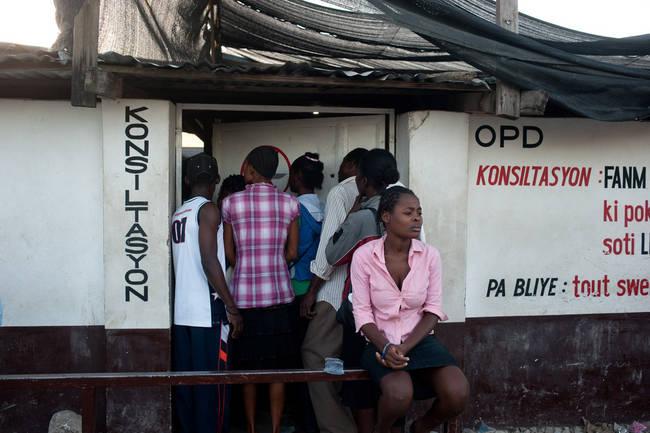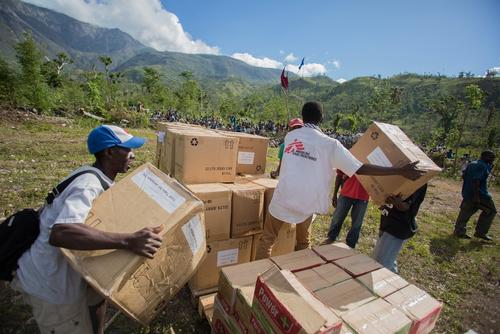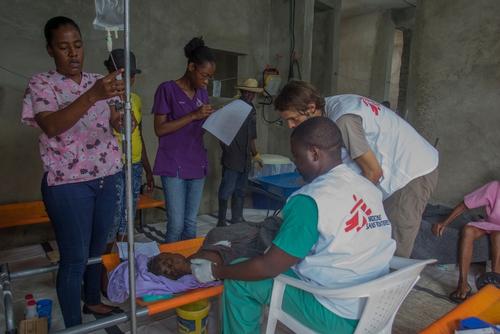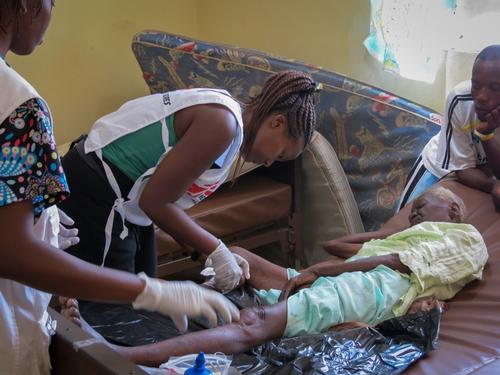Three years after the 2010 earthquake, the Haitian healthcare system is still devastated. On 12 January 2010, most hospitals in the earthquake zone were either destroyed or seriously damaged.
Médecins Sans Frontières (MSF) continues to manage four hospitals built to replace the temporary structures that it set up immediately after the earthquake, where tens of thousands of Haitians benefit from free, high-quality care. However, the Haitian authorities are unlikely to take over MSF’s activities in the foreseeable future.
“The transition process is much too slow,” says Joan Arnan, MSF’s head of mission in Haiti. “That’s because Haitian institutions are weak, donors have not kept their promises, and the government and the international community have failed to set clear priorities.”

The inadequate response to the cholera epidemic – the other catastrophe that struck Haiti in 2010 – reveals the delays in the health system’s recovery. Haiti has experienced recurring outbreaks of the disease. During 2012, more than 22,900 cholera victims received care in MSF’s cholera treatment centres in Port-au-Prince and Léogâne. The number of cholera patients increased after hurricanes Isaac and Sandy, when rains caused open sewers to overflow and led to the spread of the bacteria that causes the disease. Despite a recent drop in the number of patients, as of late 2012, MSF was still treating more than 500 patients each week.
“The majority of the population lacks access to drinking water and proper sanitation, but cholera treatment has still not been properly integrated into the few existing public health facilities,” Arnan explains. For example, in Léogâne, approximately 30 kilometres from Port-au-Prince and the city closest to the epicentre of the earthquake, several humanitarian organisations fighting the epidemic have pulled out for lack of funding. The number of patients admitted to MSF’s treatment unit has grown. The same is true in Port-au-Prince. MSF cholera treatment centres in Delmas and Carrefour remain the only places where patients can seek treatment and, instead of a decline, MSF is seeing an increase of patients as a direct result of other organisations leaving.
Much of Léogâne was destroyed by the quake, and today the city resembles a huge construction site. Most of the people who survived have been re-housed. However, the MSF hospital is the only facility in the region offering free round-the-clock care in case of emergencies.
MSF’s temporary facility in Léogâne has been replaced by a building made of shipping containers, which opened in September 2010. In addition to maternity care, the hospital offers emergency treatment and has a surgical unit. Most of the surgeries performed involve women requiring caesarean sections and victims of road accidents. Outpatient consultations for pregnant women and children under five years of age are held in another building.
The hospital is drawing increasing numbers of patients. Some even come from Port-au-Prince, indicating a lack of adequate care even in the capital. The number of births averages 600 per month, with peaks of more than 800. Other medical facilities regularly refer patients in labour to the MSF hospital, from simple cases to complicated ones that require a caesarean section and a 24-hour operating theatre.
“The hospital fills a gap that existed well before the earthquake,” Arnan says. “Most Haitians did not have access to medical care before 12 January 2010, whether because of the lack of available services or because they didn’t have enough money. We came in response to the catastrophe and intended to stay until reconstruction could get under way and the public health facilities could take over. Unfortunately, it’s been three years and almost nothing has changed in terms of access to care.”
Overview of MSF programmes in Haiti
MSF launched its first projects in Haiti in 1991, carrying out emergency programmes during natural disasters and crisis situations.
Over the 10 months following the January 2010 earthquake, MSF teams treated 358,000 patients, performing 16,570 surgical procedures and assisting 15,100 births. More than 80 per cent of the $155 million raised in 2010 for MSF emergency operations in Haiti was spent during that period.
From late October 2010, MSF responded to the cholera outbreak, treating 170,000 patients in a year at a cost of $45 million.
Today, MSF still manages four hospitals in the earthquake-affected area: the 110-bed reference centre for obstetric emergencies that opened in April 2011 in Delmas; a 130-bed trauma hospital transferred to Drouillard, close to the slum of Cité Soleil, in May 2011; the 110-bed surgical centre Nap Kenbe, which opened in February 2012 within Tabarre industrial park and a 160-bed hospital in Léogâne.
In 2012, about 30,000 patients have been admitted to these hospitals. MSF also treated nearly 23,000 cholera cases in specific treatment centres in Port-au-Prince and Léogâne.
MSF currently employs nearly 2,500 people in Haiti, 95 per cent of whom are Haitian. Human resources represent about half of the total annual budget of $50 million.





